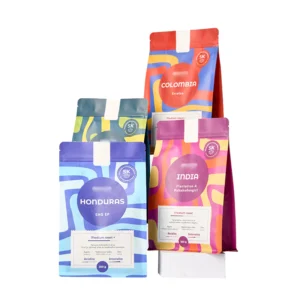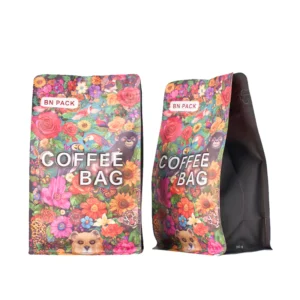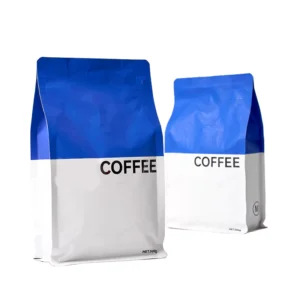Coffee is more than just a drink; it’s a global cultural cornerstone and a powerhouse in the global economy. In the competitive coffee industry, The Importance of Coffee Packaging cannot be overstated.
Well-crafted packaging not only preserves the quality of the coffee but also makes a lasting impression on consumers. It can influence purchasing decisions and reflect a brand’s values. This article will dive into how packaging impacts freshness, branding, sustainability, and customer experience.v

The Role of Coffee Packaging
When it comes to coffee, packaging plays a crucial role in preserving its freshness and quality. The right packaging doesn’t just look good on a shelf—it protects the coffee from external factors that could compromise its flavor. Here’s how it works:
Oxygen Exposure
Oxygen is one of the biggest enemies of fresh coffee. When coffee beans are exposed to air, they quickly lose their flavor and aroma. Airtight, multi-layered packaging, like foil-lined bags, creates a strong barrier that keeps oxygen out. This type of packaging ensures that the coffee remains fresh, locking in the rich, bold flavors from the moment it’s packaged to when it’s opened by the customer.
Valves and Degassing
Freshly roasted coffee releases carbon dioxide, which, if trapped in the bag, can cause it to swell or burst. A degassing valve allows this gas to escape while keeping oxygen from entering. This simple but effective feature maintains the bag’s integrity, preventing damage and preserving the coffee’s full flavor. Thanks to degassing valves, the coffee stays fresh without the risk of packaging issues.
Light Protection
Exposure to light, especially UV light, can degrade the quality of coffee, causing it to lose its flavor and aroma. Packaging that blocks out light, such as opaque or dark-colored bags, prevents these harmful rays from reaching the coffee. This protects the beans and helps maintain the freshness and richness of their taste, ensuring a superior coffee experience for the consumer.
The Aesthetics of Coffee Packaging
In the competitive coffee market, the aesthetic appeal of packaging plays a significant role in attracting customers and setting a brand apart.
Branding Through Design
Branding Through Design relies heavily on the power of graphics, typography, and color to grab attention and create a visual identity. High-end, minimalistic designs convey a sense of luxury and sophistication, while vibrant, playful packaging can make a brand feel fun, approachable, and energetic. Whether it’s elegant simplicity or bold creativity, the design communicates the essence of the brand to consumers.
Consumer Perception and Premium Quality
Consumer Perception and Premium Quality are strongly tied to the look and feel of packaging. Luxurious packaging, with its premium materials and thoughtful design, often increases the perceived value of the coffee inside.
Customers associate carefully crafted packaging with high-quality coffee. Furthermore, packaging provides an opportunity to reflect the source, origin, and sustainability of the product. Highlighting these aspects can elevate the coffee’s image and resonate with conscious consumers who value ethical sourcing and environmental impact.
Customization and Personalization
Customization and Personalization are growing trends in coffee packaging, especially for gifts or limited-edition releases. Personal touches, like custom names, messages, or exclusive designs, make the product feel special and unique.
Personalized packaging strengthens emotional connections with customers, creating a memorable experience that extends beyond the product itself. It’s an effective way to make a coffee offering stand out and generate excitement around new releases or seasonal offerings.
Key Customer-Focused Features That Emphasize the Importance of Coffee Packaging
Coffee packaging plays a crucial role in creating a great customer experience by offering features that add convenience and enhance product quality.
Resealability is essential for keeping coffee fresh after opening. Packaging with zip-locks, fold-over tops, or adhesive strips allows customers to enjoy their coffee over time without worrying about freshness.
Easy-to-Open Designs make it simple for customers to access the coffee without struggling or needing scissors, enhancing their overall experience.
Clear, Informative Labels provide vital details such as the coffee’s origin, roast level, and flavor profile, helping customers make informed decisions. These features improve convenience, build trust, and elevate the customer experience, making coffee packaging an essential factor in encouraging repeat business.
Environmental Impact and Sustainability in Coffee Packaging
As sustainability continues to drive consumer behavior, coffee brands are increasingly focusing on the environmental impact of their packaging.
Eco-friendly Materials
Eco-friendly Materials play a crucial role in this shift. More and more companies are opting for biodegradable, recyclable, and compostable packaging options. Innovations like plant-based plastics are becoming popular, offering a more sustainable alternative to traditional materials.
This change not only helps reduce waste but also resonates with eco-conscious consumers who want their purchases to reflect their values.
Reducing Waste
Brands are also taking steps to Reduce Waste by minimizing packaging and adopting reusable containers. This approach not only reduces environmental impact but also appeals to customers who value sustainability.
Zero-waste initiatives are gaining traction, with many coffee brands opting for packaging that can be reused or refilled. These eco-friendly efforts are influencing consumer decisions, with people becoming more likely to choose brands that prioritize sustainability.
Certification Labels
Certification Labels play a significant role in boosting consumer trust and demonstrating a brand’s commitment to ethical and sustainable practices. Labels such as Fair Trade, organic, and other eco-certifications help reassure consumers that the coffee they purchase supports responsible sourcing and production.
These certifications not only benefit the environment but also align with the growing demand for transparency and corporate responsibility in today’s market.
Practical Considerations for Coffee Brands
Coffee brands need to consider several Practical Considerations when deciding on their packaging strategy.
Costs vs Benefits of High-Quality Packaging
While premium packaging might carry a higher initial cost, it helps maintain the freshness and flavor of the coffee, enhancing its appeal to customers. This packaging choice also impacts shipping, storage, and shelf display. Durable, efficient packaging prevents damage, optimizes storage, and ensures the product looks great on store shelves, driving sales.
Consumer Expectations and Trends
Consumer Expectations and Trends have shifted as coffee drinkers seek fresh, high-quality products that fit their modern lifestyles. To meet these demands, brands need packaging that preserves freshness and allows easy access.
With trends like single-serve pods, subscription models, and on-the-go options rising, brands that adapt packaging to convenience and quality are more likely to resonate with today’s busy consumers. Meeting these expectations is key to attracting a loyal following.
Regulatory Compliance
Regulatory Compliance is another crucial factor. Coffee brands must adhere to food safety regulations that ensure packaging is safe and compliant with industry standards.
Clear and informative labeling is vital, offering transparency about expiration dates, nutritional information, and certifications. Labels with these details build consumer trust, demonstrating the brand’s commitment to quality and compliance. This transparency reassures customers, making them more likely to purchase and remain loyal.
Innovations in Coffee Packaging
Innovations in coffee packaging are changing the way we experience and enjoy our favorite beverages.
Smart Packaging Technology
Smart packaging technology is at the forefront of this evolution, with QR codes, freshness indicators, and NFC-enabled packaging becoming more common. These technologies not only help consumers track their coffee’s journey from roaster to cup but also guarantee authenticity, allowing them to explore more about the brand and product.
For producers, these innovations offer better traceability, and for consumers, they provide an enriched, transparent experience.
Innovations in Sustainable Packaging
Sustainable packaging is also seeing rapid innovation. Biodegradable or recyclable coffee pods are gaining traction, with brands like Nespresso offering recyclable aluminum pods and Café Deva leading with compostable pods made from plant-based materials.
Paper-based and plant-based alternatives to plastic and foil bags are becoming popular choices too, with companies like Ecovia introducing paper coffee bags and CoffeeSock offering organic cotton filters. These innovations are a great step toward reducing environmental impact while still maintaining the freshness of the coffee.
Packaging for New Coffee Trends
The rise of new coffee trends like cold brew and nitro coffee has also sparked unique packaging solutions. Brands are now offering innovative cans and bottles with nitrogen-infused packaging, like Stumptown’s Cold Brew in sleek cans, to preserve freshness and enhance flavor.
The shift towards ready-to-drink (RTD) beverages is driving packaging innovation, leading to eco-conscious, functional, and attractive designs that reflect both the growing popularity of these beverages and the demand for sustainability.
Affordable Packaging Solutions for Small Coffee Roasters
For small coffee roasters, finding the right balance between quality and budget is key. Flexible packaging options, like stand up pouches, provide an affordable and sustainable choice. These pouches can come in biodegradable or recyclable materials, which appeal to eco-conscious customers.
Digital printing also makes it possible for roasters to print smaller batches, allowing for custom designs or limited-edition releases without overspending.
Foil-lined bags and recyclable plastics offer excellent protection, keeping coffee fresh while preserving its quality.
These cost-effective packaging solutions help small roasters maintain high standards and strengthen their brand, all while keeping packaging costs manageable.
Recommended Coffee Bags
Conclusion
In conclusion, coffee packaging plays a crucial role in protecting the product, showcasing its quality, and creating a strong brand identity. The right packaging not only keeps the coffee fresh but also connects with consumers on an emotional level, influencing their buying decisions.
With eco-friendly options, like flexible packaging, small roasters can offer sustainable choices while maintaining cost-effectiveness. If you’re ready to take your coffee brand to the next level, consider quoting flexible coffee packaging with BN Pack today!
FAQ
How to Balance Cost and Sustainability in Coffee Packaging?
To balance cost and sustainability in coffee packaging, choose materials that are both affordable and eco-friendly. Use recycled or biodegradable materials like kraft paper, cardboard, or compostable plastics. Opt for minimal packaging to reduce waste. Compare prices of sustainable options and find suppliers who offer eco-friendly choices at reasonable prices. Make sure your packaging protects the coffee without using excessive resources.
What Consumers Look for in Coffee Packaging?
Consumers want packaging that keeps coffee fresh, easy to open, and visually appealing. They also care about eco-friendliness and sustainability. Clear labeling that shows the coffee’s origin, roast date, and flavor profile builds trust. Packaging should be convenient, durable, and ideally, reusable or recyclable. Easy storage and resealability also matter to consumers who want to maintain freshness over time.
How Coffee is Packaged?
Coffee is typically packaged in bags made from materials like plastic, foil, or paper. The most common method is using vacuum-sealed bags, which remove air to preserve freshness. Other methods include using one-way valves that allow carbon dioxide to escape while preventing air from entering. Some companies also package coffee in cans or glass jars to protect it from light and moisture.
How Long Does Packaged Coffee Last?
Packaged coffee can last anywhere from a few months to a year, depending on storage conditions and packaging. Vacuum-sealed bags with one-way valves can extend freshness. Roasted coffee tends to lose its flavor faster, so it’s best to consume it within 2-3 weeks for optimal taste. Green coffee beans last longer and can stay fresh for up to a year, but proper storage is essential to delay aging.
Is Coffee Packaging Recyclable?
Many coffee packaging materials are recyclable, but it depends on the type used. Paper bags, cardboard boxes, and some plastic bags can be recycled. However, bags with aluminum layers or foil linings may not be recyclable in most curbside programs. Always check local recycling guidelines. Some companies are now offering fully recyclable or compostable coffee bags to improve sustainability.
How Coffee Packaging Impacts Flavor and Freshness?
Coffee packaging is crucial in maintaining flavor and freshness. Packaging that shields the coffee from air, light, and moisture preserves its aroma and taste. Vacuum-sealing and using one-way valves help to keep the beans fresh by allowing carbon dioxide to escape without letting oxygen in. Poor packaging can lead to stale, bitter coffee, so invest in packaging that ensures the beans stay protected until they reach the consumer.
How to Design Coffee Packaging?
Designing coffee packaging involves more than just a catchy logo. Focus on creating a visually appealing design that communicates your brand’s identity. Choose colors and fonts that reflect the style of coffee you’re selling. Consider using eco-friendly materials to appeal to sustainability-conscious customers. Include essential information like the roast date, coffee origin, and brewing tips. Make sure the packaging is functional, easy to open, and resealable to maintain freshness.







